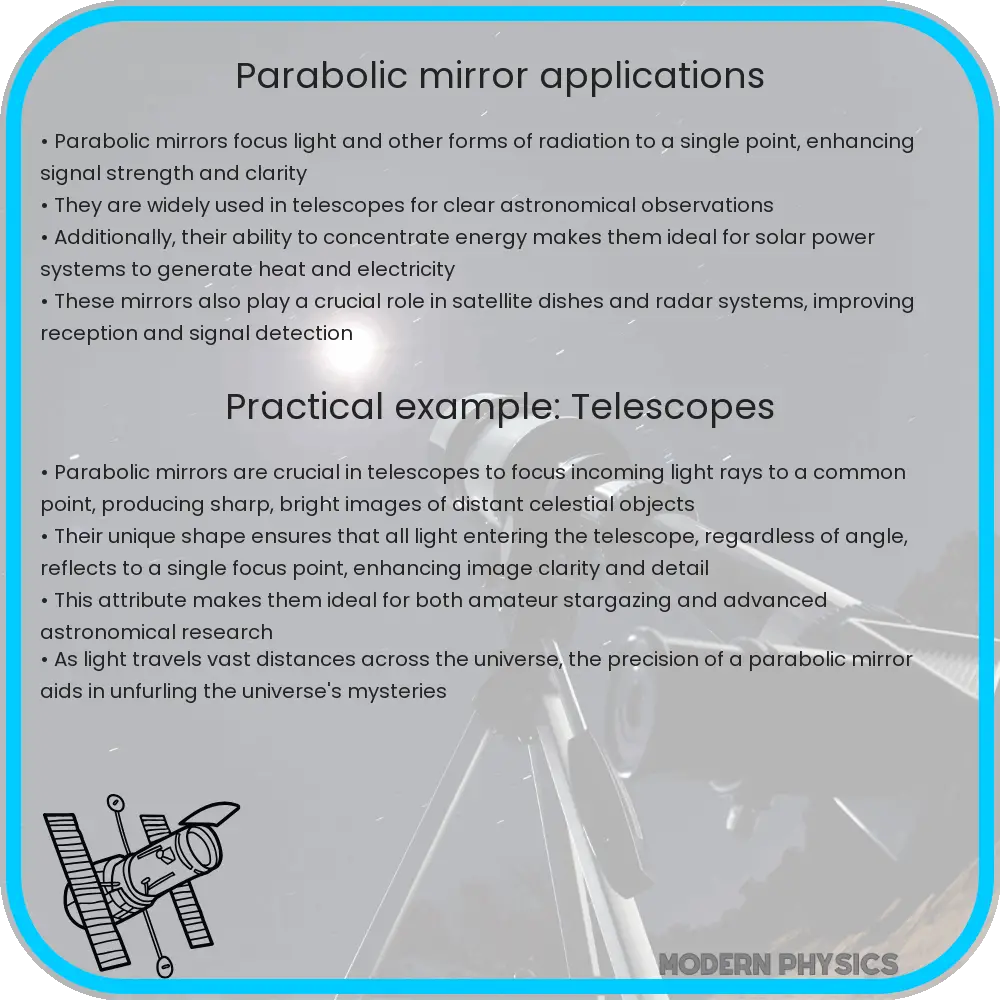Explore the diverse uses of parabolic mirrors in precision tasks, solar power, and telescopes, showcasing their impact on technology and science.

Exploring the Multifaceted Applications of Parabolic Mirrors
Parabolic mirrors, with their unique ability to reflect light into a single focal point, have revolutionized various industries and scientific fields. These mirrors, characterized by their parabola-shaped reflective surfaces, harness the principles of geometry and optics to serve precision tasks, solar power generation, and astronomical observations. This article delves into the applications of parabolic mirrors, highlighting their versatility and impact.
Precision and Scientific Research
In the realm of scientific research and precision applications, parabolic mirrors are indispensable. They are pivotal in focusing light for optical instruments, such as telescopes and lasers, enhancing clarity and accuracy. For instance, in telescopes, a parabolic mirror’s ability to correct spherical aberration allows astronomers to obtain sharp and focused images of distant celestial objects. Similarly, in laser systems, these mirrors focus light beams to precise points, enabling high-precision cutting, engraving, and medical procedures.
Solar Power Generation
The application of parabolic mirrors in solar power generation exemplifies the innovative use of renewable energy sources. These mirrors are the heart of concentrated solar power (CSP) systems, where they concentrate sunlight onto a small area, typically a receiver. The concentrated light is then used to heat a fluid, producing steam that drives a turbine to generate electricity. The efficiency of CSP plants hinges on the precision of parabolic mirrors, which allows them to harness solar energy effectively and sustainably.
Enhancing Telescope Performance
Astronomy benefits significantly from the use of parabolic mirrors, particularly in reflecting telescopes. By eliminating spherical aberration, these mirrors provide astronomers with clearer and more detailed views of the universe. The Hubble Space Telescope, for example, employs a large parabolic mirror to capture high-resolution images of distant galaxies, stars, and planets, contributing immensely to our understanding of the cosmos.
The versatility of parabolic mirrors extends beyond these applications, impacting areas such as telecommunications, research, and even art. Their ability to focus light and energy precisely makes them invaluable tools in advancing technology and science. As we continue to explore and innovate, the potential uses for parabolic mirrors seem limitless, promising new advancements and discoveries across various fields.
Telecommunications and Beyond
Parabolic mirrors also play a crucial role in the field of telecommunications, particularly in satellite dishes and radar systems. These mirrors focus and direct radio waves, enabling the transmission and reception of data over vast distances. The precision offered by parabolic mirrors ensures high-quality signal strength and reliability in communication networks, making them essential components in global connectivity.
Innovative Applications in Art and Architecture
The intersection of technology and creativity has led to the innovative use of parabolic mirrors in art and architecture. Artists and architects harness the reflective properties of these mirrors to create installations and structures that interact with light in unique ways. These applications not only showcase the aesthetic versatility of parabolic mirrors but also illustrate how scientific principles can be applied to create visually stunning and thought-provoking works.
The Future of Parabolic Mirrors
As technology advances, the potential applications for parabolic mirrors continue to expand. Research into materials and coatings is underway to enhance their efficiency and durability, particularly for outdoor applications like solar power generation. Furthermore, developments in manufacturing techniques aim to reduce costs and increase the accessibility of these mirrors for various applications, from small-scale scientific research to large-scale industrial projects.
Conclusion
Parabolic mirrors, with their unique geometric properties and ability to focus light and energy, have become indispensable tools across a wide range of fields. From enhancing the precision of scientific instruments to enabling the generation of renewable energy, these mirrors have demonstrated their versatility and impact. The innovative use of parabolic mirrors in telecommunications, art, and architecture further underscores their significance in modern society. As we look to the future, the ongoing advancements in technology and materials science promise to expand the applications and efficiency of parabolic mirrors, ensuring their continued relevance in advancing human knowledge and capability. Their role in shaping the future of energy, science, and art highlights the enduring intersection of geometry, physics, and creativity.
